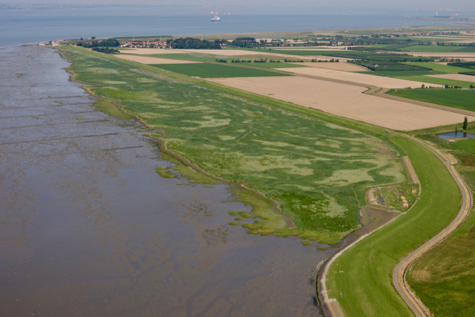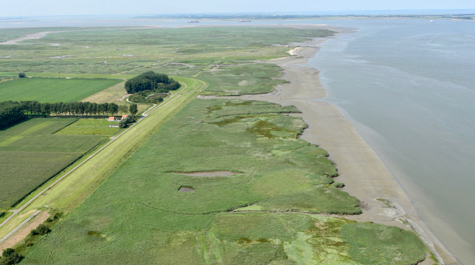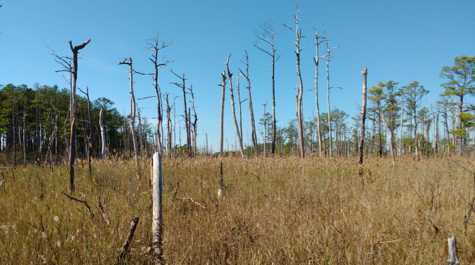Coastal wetlands will survive rising seas, but only if we let them
Global study confirms importance of “accommodation space”
When Florence slogged ashore in North Carolina last week, coastal wetlands offered one of the best lines of defense against the hurricane’s waves and surge.
A new study predicts such wetlands will survive rising seas to buffer the world’s coastlines against future storms and provide their many other ecological and economic benefits, but only if humans preserve the room needed for the wetlands to migrate inland—what scientists call “accommodation space.”
The study, published in Nature the day before Florence made landfall, addressed a major uncertainty in how saltmarshes and mangroves will respond to sea-level rise. It was authored by an international research team with members in the U.K., U.S., Belgium, Germany, and Australia. Associate Professor Matt Kirwan of the Virginia Institute of Marine Science was the sole U.S.-based contributor.
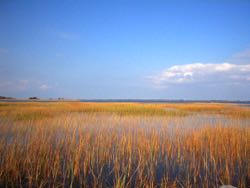
The study’s lead author, Dr. Mark Schuerch of the U.K.-based University of Lincoln, says “Rather than being an inevitable consequence of global rising sea levels, our findings indicate that large-scale coastal wetland loss might be avoidable if sufficient additional space can be created by increasing the number of innovative ‘nature-based adaptation’ solutions to coastal management.”
Adds Kirwan, “Whether coastal wetlands get bigger or smaller in the future depends on how much dry land is lost to sea-level rise, and how fast wetlands move into that submerged land.”
A novel modeling approach
The study was motivated by a history of conflicting predictions concerning the fate of coastal wetlands in a warming world.
Says Schuerch, “Recent global assessments have suggested that sea-level rise has already overwhelmed the ability of many marshes and mangroves to build up vertically, leading to widespread loss of coastal wetlands, while field measurements and localized models of salt-marsh accretion show that most large-scale assessments have overestimated wetland vulnerability.”
Kirwan’s previous work helps explain these discrepancies, and played a key role in motivating the current study. He says “Global predictions of marsh loss appear alarming, but they stem from simple models that don’t simulate the dynamic feedbacks that allow marsh soils to build faster as marshes become more flooded.” That dynamic, says Kirwan, “will allow marshes to adapt not only to present rates of sea-level rise but the accelerated rates predicted for coming decades.”
In their Nature study, the researchers integrated the previously independent approaches, using a novel modelling method that combined global simulations of sea-level rise, population growth, and other factors with localized measurements and simulations of saltmarsh accretion.
Their results counter previous estimates of global coastal-wetland loss—up to 90% in some studies—instead predicting that wetland area could actually increase as sea level rises. Indeed, the researchers estimate gains of up to 60% in coastal wetland acreage, but with two important caveats—the capacity for marshes to migrate inland sans seawalls or dikes, and no decrease in sediment supply.
According to the authors, “Our simulations suggest that global wetland resilience is primarily driven by the availability of accommodation space, which is strongly influenced by the building of anthropogenic infrastructure in the coastal zone.”
A key threshold
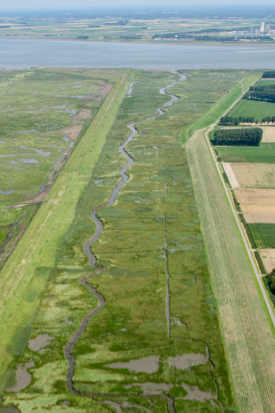 The researchers used human population density to gauge the likelihood that a coastal area is protected by the kind of infrastructure that would block wetland migration, and found a key threshold at 20 people per square kilometer. Building coastal-protection measures in areas with lower population densities will lead to global marsh loss, while reserving coastal-protection measures for areas with higher densities will lead to marsh gain. The 20-person threshold applies under all tested scenarios of sea-level rise and population growth out to the year 2100.
The researchers used human population density to gauge the likelihood that a coastal area is protected by the kind of infrastructure that would block wetland migration, and found a key threshold at 20 people per square kilometer. Building coastal-protection measures in areas with lower population densities will lead to global marsh loss, while reserving coastal-protection measures for areas with higher densities will lead to marsh gain. The 20-person threshold applies under all tested scenarios of sea-level rise and population growth out to the year 2100.
Explains Kirwan, “If dikes are built to protect areas with lower population densities, say 5 people per square kilometer, then much of the coast will be diked and marshes will have nowhere to go.” Under such a scenario, the Nature study shows a 30% loss of coastal wetlands as seas rise to the highest projected 2100 levels. The study’s most optimistic, 60% prediction of wetland gain occurs under a much greater, 300-person-km2 threshold scenario, essentially allowing coastal wetlands to migrate inland unimpeded until they are lapping at urban shores. A simulation at the 20-person threshold predicts a global wetland gain of 37%.
In an interesting twist, the 20-person threshold happens to be the current global average population density above which coastal communities are protected by some kind of infrastructure. Thus, for coastal wetlands to expand in the face of projected increases in both sea-level rise and human population, accommodation space must be not only preserved but expanded.
A growing movement would expand accommodation space through the use of what scientists call “natural and nature-based features” for coastal resilience. Schuerch says replacing dikes and other traditional coastal flood defenses with these “NNBFs” would “enable coastal wetlands to migrate inland through.. nature reserve buffers in upland areas surrounding coastal wetlands. If these are strategically scaled up they could help coastal wetlands adapt to rising sea levels and protect rapidly increasing global coastal populations.”
Implications for the U.S.
Kirwan stresses that the Nature study reveals several important differences between coastal wetlands and their projected fates in different parts of the world.
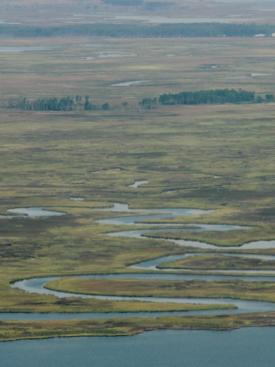 “In China and many European countries,” he says, “many marshes are bordered by dikes, while in the U.S., they’re generally bordered by forests.” Thus Eurasian marshes already suffer from a lack of accommodation space, while Kirwan’s research team has seen ample local evidence of landward saltmarsh migration including the appearance of “ghost forests.”
“In China and many European countries,” he says, “many marshes are bordered by dikes, while in the U.S., they’re generally bordered by forests.” Thus Eurasian marshes already suffer from a lack of accommodation space, while Kirwan’s research team has seen ample local evidence of landward saltmarsh migration including the appearance of “ghost forests.”
“We’ve seen widespread conversion of forests to marshes here in the U.S. already," says Kirwan, "and millions of acres of low elevation, rural land will convert to wetlands in the future in places like Chesapeake Bay and the Gulf Coast.”
Kirwan notes the Nature study also predicts that regional differences in the fate of saltmarshes will be influenced by differences in sediment availability, helping to explain what at first might seem a paradox.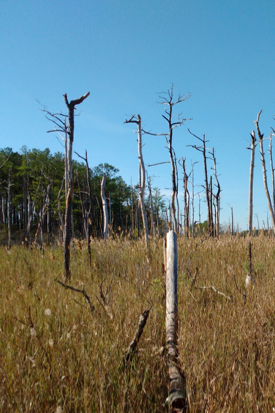
“Our modeling suggests that many European saltmarshes will survive sea-level rise despite a lack of accommodation space for inland migration, because there's enough sediment to allow the marshes to grow vertically,” says Kirwan. “In the U.S., many rivers supply insufficient sediment for marshes to grow vertically, so those marshes will have to migrate inland to survive sea-level rise.”


